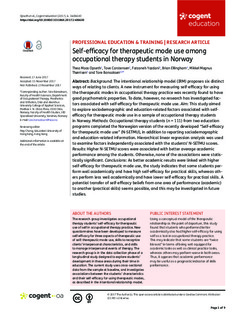| dc.contributor.author | Opseth, Thea M. | |
| dc.contributor.author | Carstensen, Tove | |
| dc.contributor.author | Yazdani, Farzaneh | |
| dc.contributor.author | Ellingham, Brian | |
| dc.contributor.author | Thørrisen, Mikkel Magnus | |
| dc.contributor.author | Bonsaksen, Tore | |
| dc.date.accessioned | 2017-12-01T14:10:53Z | |
| dc.date.available | 2017-12-01T14:10:53Z | |
| dc.date.created | 2017-11-15T15:13:39Z | |
| dc.date.issued | 2017 | |
| dc.identifier.citation | Cogent Education. 2017, 4 (1), 1-9. | nb_NO |
| dc.identifier.issn | 2331-186X | |
| dc.identifier.uri | http://hdl.handle.net/11250/2468801 | |
| dc.description.abstract | Background: The intentional relationship model (IRM) proposes six distinct ways of relating to clients. A new instrument for measuring self-efficacy for using the therapeutic modes in occupational therapy practice was recently found to have good psychometric properties. To date, however, no research has investigated factors associated with self-efficacy for therapeutic mode use. Aim: This study aimed to explore sociodemographic and education-related factors associated with self-efficacy for therapeutic mode use in a sample of occupational therapy students in Norway. Methods: Occupational therapy students (n = 111) from two education programs completed the Norwegian version of the recently developed “Self-efficacy for therapeutic mode use” (N-SETMU), in addition to reporting sociodemographic and education-related information. Hierarchical linear regression analysis was used to examine factors independently associated with the students’ N-SETMU scores. Results: Higher N-SETMU scores were associated with better average academic performance among the students. Otherwise, none of the associations were statistically significant. Conclusions: As better academic results were linked with higher self-efficacy for therapeutic mode use, the study indicates that some students perform well academically and have high self-efficacy for practical skills, whereas others perform less well academically and have lower self-efficacy for practical skills. A potential transfer of self-efficacy beliefs from one area of performance (academic) to another (practical skills) seems possible, and this may be investigated in future studies. | nb_NO |
| dc.language.iso | eng | nb_NO |
| dc.publisher | Cogent OA | nb_NO |
| dc.rights | Navngivelse 4.0 Internasjonal | * |
| dc.rights.uri | http://creativecommons.org/licenses/by/4.0/deed.no | * |
| dc.title | Self-efficacy for therapeutic mode use among occupational therapy students in Norway | nb_NO |
| dc.type | Journal article | nb_NO |
| dc.type | Peer reviewed | nb_NO |
| dc.description.version | publishedVersion | nb_NO |
| dc.source.pagenumber | 1-9 | nb_NO |
| dc.source.volume | 4 | nb_NO |
| dc.source.journal | Cogent Education | nb_NO |
| dc.source.issue | 1 | nb_NO |
| dc.identifier.doi | 10.1080/2331186X.2017.1406630 | |
| dc.identifier.cristin | 1514523 | |
| dc.description.localcode | © 2017 The Author(s). This open access article is distributed under a Creative Commons Attribution (CC-BY) 4.0 license. | nb_NO |
| cristin.unitcode | 194,65,30,0 | |
| cristin.unitname | Institutt for nevromedisin og bevegelsesvitenskap | |
| cristin.ispublished | true | |
| cristin.fulltext | original | |
| cristin.qualitycode | 1 | |

